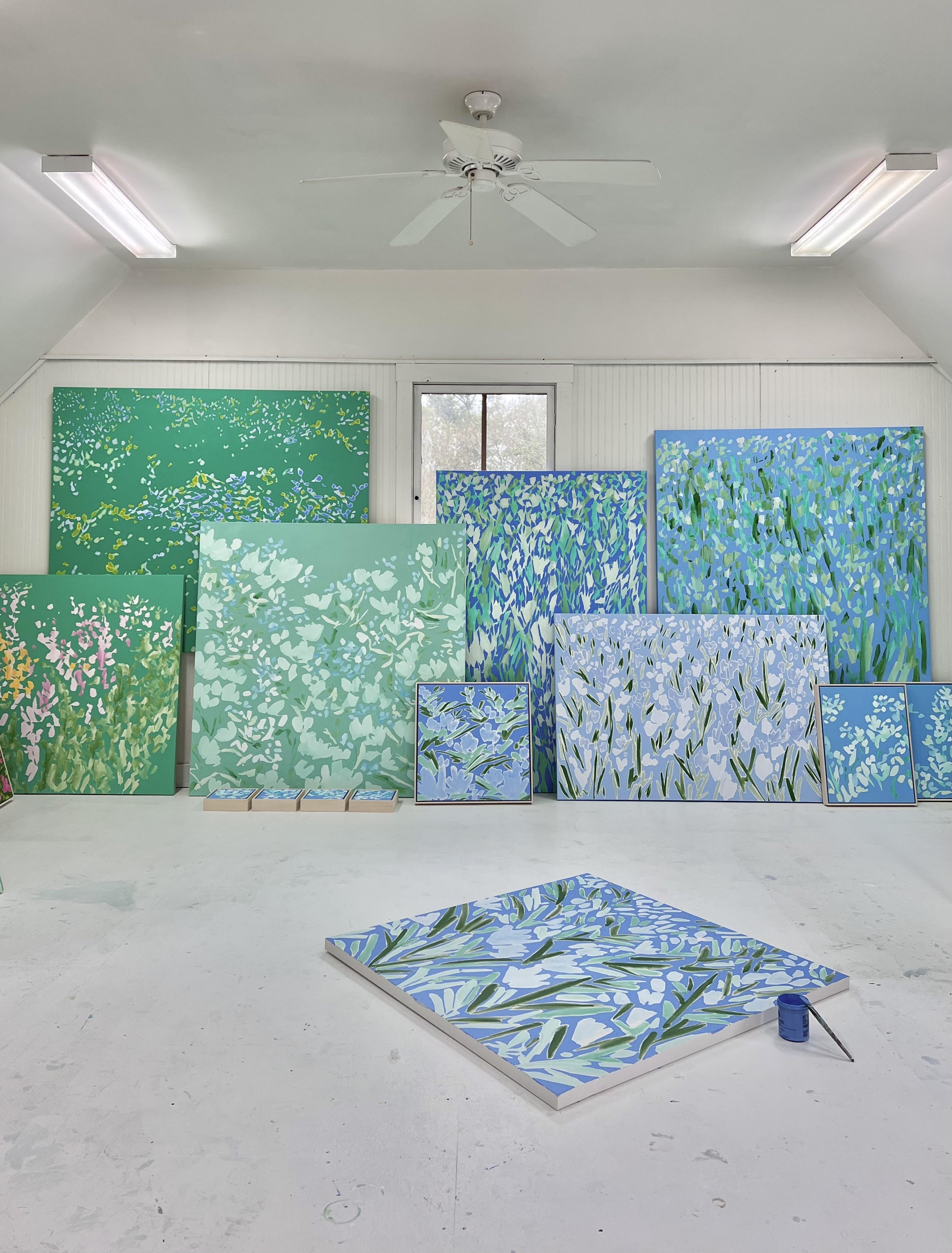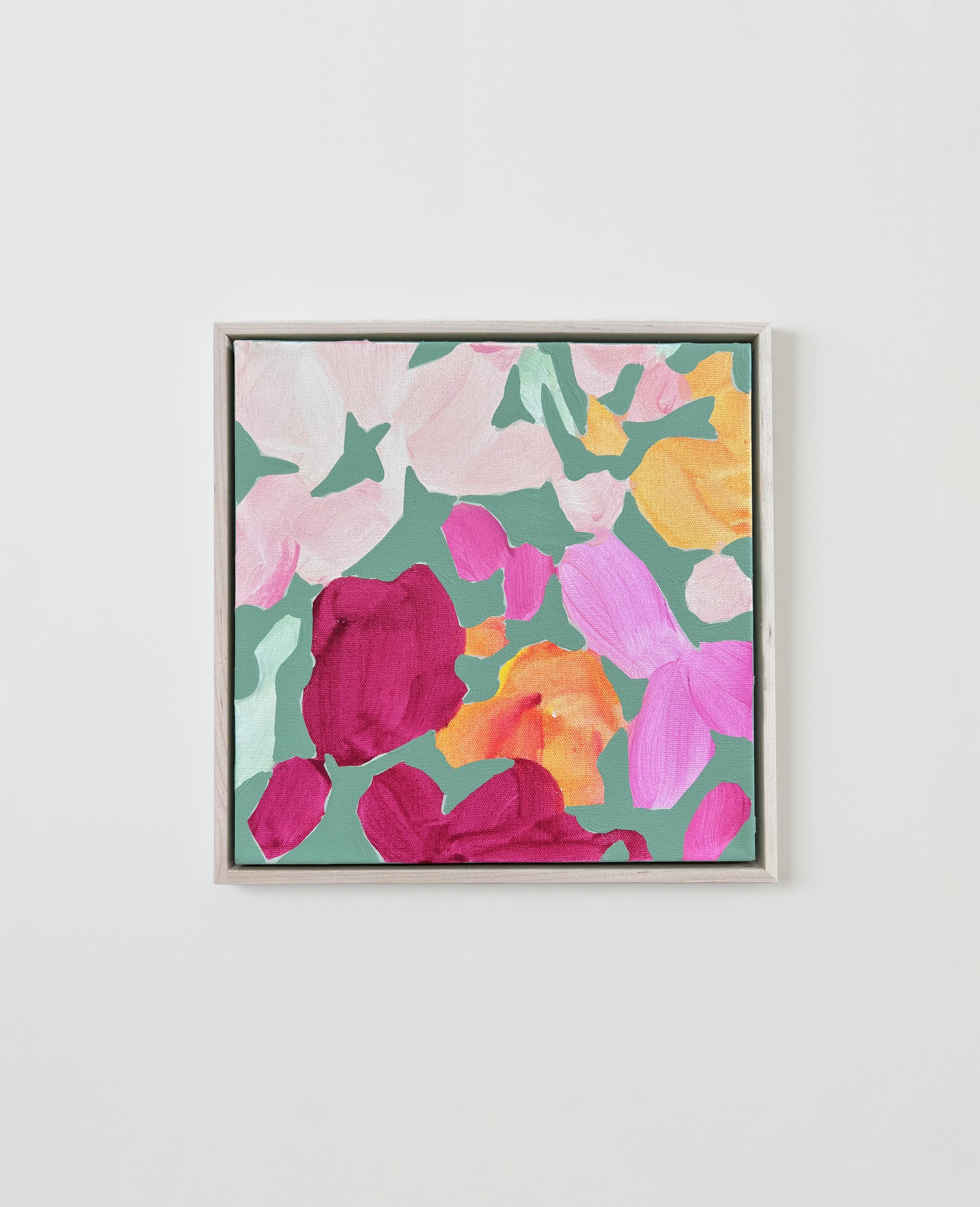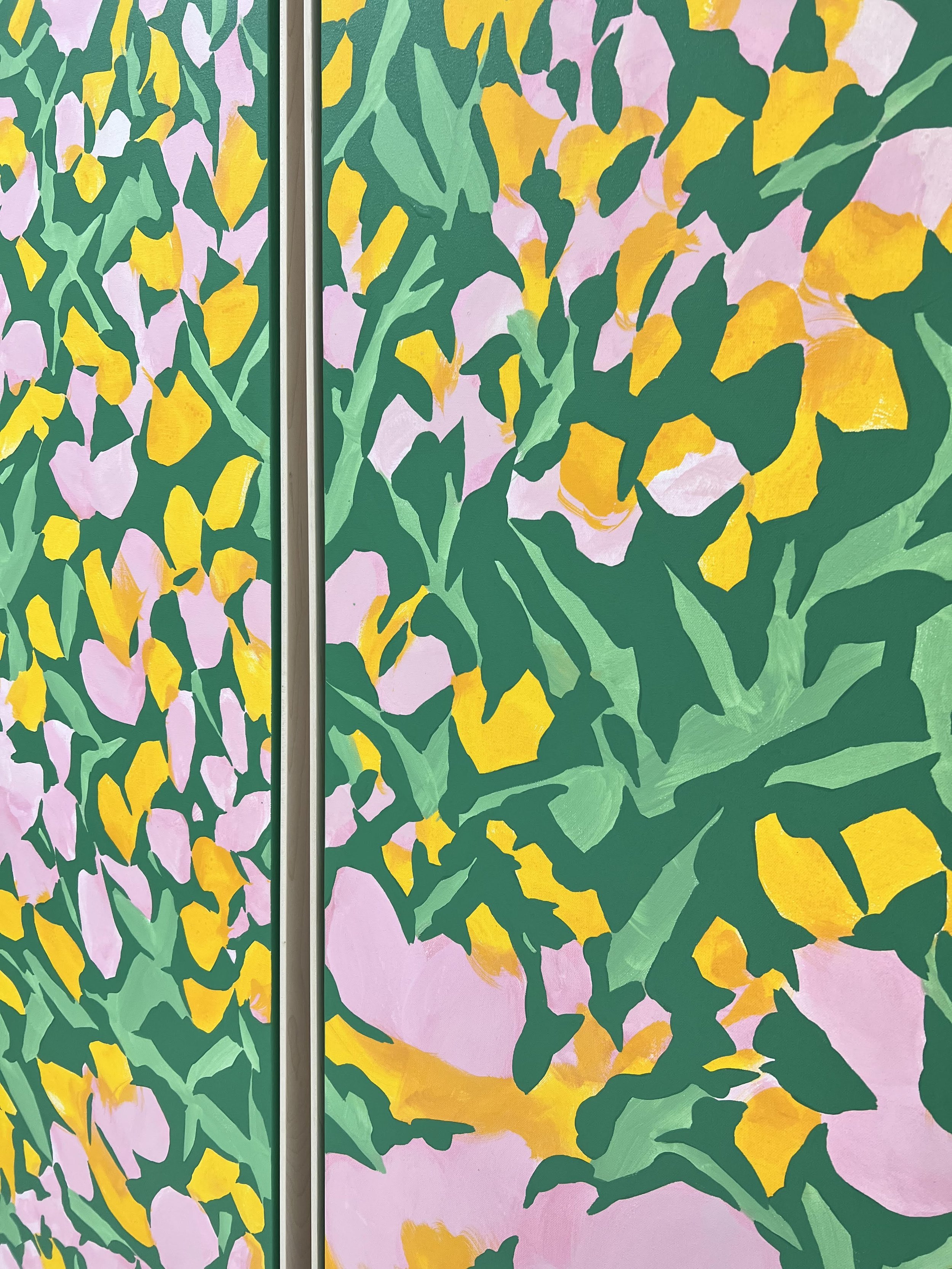KIT PORTER
Kit Porter’s studio
Beaufort, South Carolina-based artist Kit Porter has long been fascinated by the effects of time on the environment and the transformation of objects within it. She employs the language of abstraction in a painting practice that focuses on the relationship between time and change, and the seen and unseen. She is interested in the concept of diminution—the reduction in the size or extent of something—as it applies to the natural world, and was initially inspired by the unique way that the sea and weather softens and wears down the edges on objects like shells and plastics. Her paintings “fragment natural forms to act as a metaphor for the fragility of the physical world.”
Kate Mothes: What type of research do you do in preparation for your works? Is the imagery derived from anywhere in particular?
Kit Porter: I read a lot of books, and look at a lot of art, but I am very much a hands-on learner. More specifically, I learn about myself, and the way I understand the world, through painting. I truly learn something in every new work I create, and attempt to improve upon that knowledge in each subsequent painting, striving to keep my work moving in a forward direction.
Have you always been drawn to painting, or did you find it through experiments with other mediums?
In school, I was a fine art major with painting as my discipline, and while I have worked with a mix of media over the years, painting has always been incorporated into my work in one way or another. As my work shifted from exercises in realism toward abstraction, the way I thought about paint began to shift. I continually try to push the way I handle paint, experimenting with different mediums, always in an effort to make my technique communicate my concepts the best way possible. I learn something new about paint every single day.
fg1, 2022. Acrylic on canvas, 8 x 8 inches. Photo courtesy of Uprise Art
You’re painting mostly in acrylic—or oil?
I was trained traditionally to use oil, but it started to be more beneficial to use acrylic because it dries faster. About six months ago I started using oil pigment sticks, and I am just loving them. Treating them like a crayon is forcing me to let go a little bit of the control over the hyper-defined contrast of the background against the fragment. Sometimes, if I’m trying to do something conceptually, the medium changes how I think about the work. It’s almost like taking me back to my childhood.
That’s a really interesting connection to the process of painting, too, as you remove the brush from the equation and it becomes akin to drawing.
Yeah, it’s almost like taking me back to my childhood in a way. There were some kids who would make these really light crayon drawings, like shadows, and I would be breaking every crayon in half trying to get as much pigment as possible out of it. What I was trying to get was this saturated color.
What is it about abstraction that most interests you?
I love that in abstraction, the subject becomes secondary to process. For example, I do not consider myself a floral or landscape painter, but rather a painter of fragments. How I paint is more important to me than what I paint.
growing day by day, 2022. Acrylic on canvas, 80 x 120 inches. Photo courtesy of Uprise Art
Over the last few years, your work appears to have gradually shifted from ideas around the coastline and how objects are worn down by the sea to more floral-centered meadow motifs. Do you feel that these are related?
It is always interesting to hear my work looks different now than it did several years ago. To me, it is a fluid continuation of the same body of work; my mind is jumping from one stepping stone to the next, to the next. About six years ago I became interested in the way objects left by the sea are broken down over time, by collecting, studying and painting fragments of plastic I found on local beaches. I became acutely aware of the way these fragments had broken down. Some were chipped by the force of waves, others softened by sand—all shaped directly as a result of their environment. I loved this metaphor, which spoke to the fragility of the physical world. I painted these fragments for a while, but found that by focusing on the fragment as a subject, I was losing sight of what actually captivated me by these fragments: the invisible force that broke them down.
I shifted my focus to the space surrounding an object, and how, in painting, the negative space around an object could define a shape. I felt drawn to further abstraction, and shifted the way I handled paint. By increasing the space around each shape I painted, I could simultaneously decrease the size of each shape, resulting in a more effectively fragmented form. Through technique alone, devoid of subject, I was able to communicate the invisible force of breakdown more effectively. The metaphor that everything is shaped by the environment held true even in abstraction. I felt there was room to further push this concept and felt drawn to bring the subject back into play.
I decided to apply this technique to a subject in complete opposition to breakdown. To me, a field of delicate wildflowers exemplifies life, and I have found a beautiful dichotomy between growth and breakdown that I am striving to explore. How can I use paint to communicate the way I see the world—delicate and enduring, connected and fractured, growing and breaking? Quite simply, I am utilizing shape and space to communicate these dichotomies.
field guide, 2022. Acrylic on canvas, 60 x 72 inches. Photo courtesy of Uprise Art
Are there particular types of flowers or fields that you're interested in, for example that are located in certain places?
I am more interested in creating the feeling of a field of wildflowers than I am in depicting specific types of flowers. In fact, when my work becomes too floral, I feel I am drifting a little too far from my intent. Sometimes, when I’m exploring slightly larger shapes, if they become more floral looking, I’ll do a whole series and look at it and think, oh my gosh, it looks too floral! I don’t know what brings that discomfort—maybe a fear of it being too feminine or patterned, so I kind of resist that. I want paintings that feel like fields, but look like fragments. With that said, I am daily inspired by the plants that grow outside of my studio, the gardens in my neighborhood, and unexpected expanses of flowers growing in the wild. I often photograph fields and flowers for inspiration, but I do not look at photographs when I am painting.
growing day by day (detail), 2022. Acrylic on canvas, 80 x 120 inches. Photo courtesy of Uprise Art
How would you describe the relationship between your work and nature or the environment?
Like a flower among flowers, each of our lives are beautiful and fragile, and we are all shaped by our surroundings. The people we spend time with, and the places we spend time in make us who we are.
Do you begin with drawings or keep a sketchbook of any kind?
When I have ideas of paintings I want to try, I actually use a notebook and words to describe what I see in my mind. Rather than attempt to draw an image of how I want a painting to look, I try to write down how I want it to look. I do not ever know how a painting will actually look when it is finished, because my process is very reactive. Even when I visualize a painting in the middle of the night, I will wake up and write down words to describe the way it looked in my mind. The next day in the studio, I will reread the words, and attempt to put that concept into paint. I use small canvases as studies for larger canvases, and usually have multiple works going at the same time that inform one another.
Installation view at Uprise Art, New York City, 2022. Photo courtesy of Uprise Art
Is there anything you’ve learned unexpectedly or that surprised you in the studio?
A couple of years ago I was diagnosed with breast cancer, and prior to that diagnosis, my work was much more minimal with a lot of white backgrounds, more muted.
I wasn’t sure how my diagnosis it would affect my time in the studio, or the conceptual nature of my work, so I relieved myself of the pressure and expectation to continue producing work at the same rate. I told myself it was ok to slow down and listen to my intuition, and whatever was meant to come out would come out. I really allowed myself to surrender to the flow. My work started to shift and become more vibrant and colorful, and I was thinking, “Why is this happening when this is such a heavy thing I’m going through?” I began to connect that I was at a point in my life where I was receiving a tremendous amount of love and support from the people around me. I was filled with incredible warmth, and it started to come out in my work.
This further articulated the concept I was striving to communicate, that our lives are altered by our environment, but it nudged me to think about environment in a new way. Our environment is not just where we physically live, it is the setting of our lives with relation to our interpersonal connections. Something as simple as a color shift in my work, filled me with gratitude for the people in my life. As artists, we spend so much time by ourselves focusing on our work, but it is astonishing how a shift in the way paint is handled can teach us so much about what is important.
Left: The artist in her studio. Photo by Kit Porter. Right: waiting up all night, 2022. Acrylic on canvas, 36 x 24 inches. Photo courtesy of Uprise Art
See more from Kit Porter:
Painting • USA
Originally from Northeast Wisconsin, Kate Mothes is an independent contemporary art writer and organizer based in Edinburgh, Scotland.








